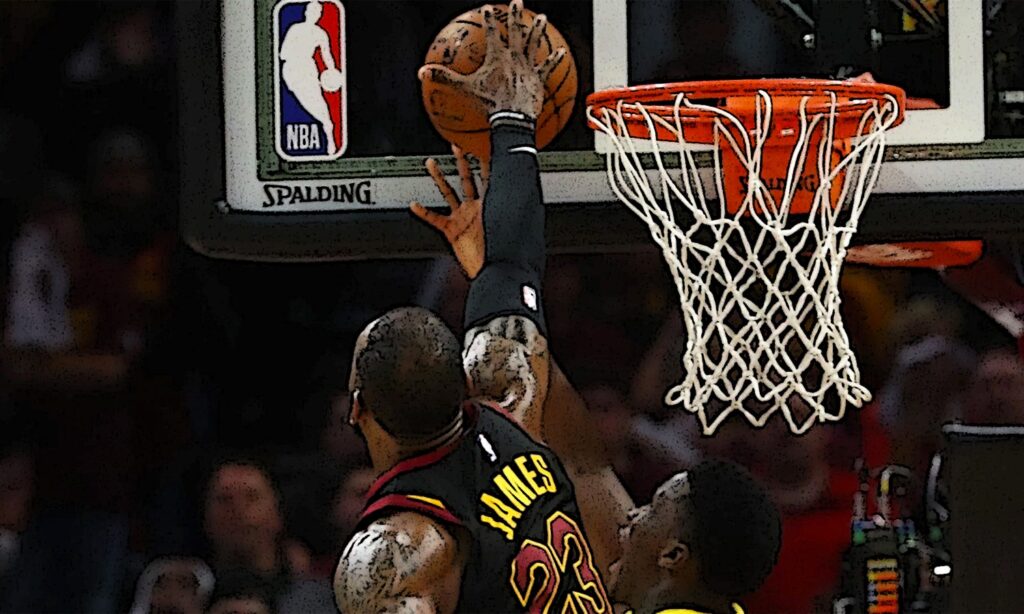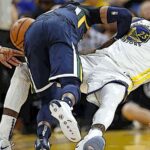In basketball, players must adhere to various rules implemented in the league rulebook.
When players violate the rules, they can penalized with personal fouls, technical fouls or a mere change in possession.
It’s clear that there are various degrees of violations that are deemed light to extremely harsh.
Mishandling of the ball falls into the lighter end of punishment, usually resulting in a turnover such as from a double dribble, travel or carry.
In some cases, it can lead to points automatically awarded to the offensive team.
As a matter of fact, the only way to earn points without scoring a basket is through goaltending or other forms of basket interference.
And generally speaking, goaltending and basket interference are interchangeably used.
What is Goaltending in Basketball?
Goaltending is an illegal shot block by the defensive player. It is called when the ball is on the downward trajectory of a shot arc, aimed at the hoop. The defender is also in violation should the ball come into contact with the backboard beforehand. The result is an automatic bucket for the offensive team.
Basically, when the ball begins its descent off the arc of a shot, the ball is illegal to touch until it bounces away from the rim for a rebound.
So, while goaltending specifically relates illegal shot blocking, there are other ways that the shot can be interfered with that carry the same result - an automatic bucket.
Take note that the NBA lumps together Goaltending with Basket Interference in their rulebook.
To summarize these rules, players cannot touch the rim, stick their hands through the basket, wedge the ball between the rim and the backboard either during the shot or while the ball is still bouncing around the rim.
Just imagine an invisible cylinder extending out above the rim.
If any part of the ball overlaps with this cylinder during a shot or while bouncing around, it is illegal to interfere with its pathway.
For example, if the ball is still bouncing above the basket, the defender cannot pull down or hang on the rim to prevent the ball from going through.
So, while he’s not touching the ball itself, he’s still interfering with the ball’s pathway.
How is Goaltending different from Blocking a Shot?
The main clue for differentiating between a legal shot block and goaltending is the progression of the ball.
As long as the ball is on the rise or just at the apex of a shot, defenders are allowed to block it.
The most tricky play to call is when the player attempts to lay it up over the defender right by the hoop.
Often you’ll see the ball hanging at the apex when the ball gets swatted away. But once there is no more upward progression, the defender will be called for goaltending.
Keep in mind that when the defender successfully blocks a dunk, goaltending is not called even if the ball is being directed downwards through the hoop.
That’s because the ball is still in the hand(s) of the offensive player.
Can Goaltending be Challenged using Instant Replay?
The short answer is “Yes”, but only once a game.
To be more specific, teams can use a Coach’s Challenge for one of the three following events:
(1) a called personal foul charged to its own team,
(2) a called out-of-bounds violation, or
(3) a called goaltending or basket interference violation
Furthermore, officials can trigger a review for goaltending or basket interference in the last two minutes of the 4th quarter or overtime.
However, if the referee doesn’t spot the violation, it cannot be reviewed.
What happens if a Goaltending Violation occurs during a Free Throw?
It’s impossible to goal tend, let alone block a shot during a free throw, because the defensive players cannot touch the ball until it reaches the basket.
Note that if the ball is interfered with by the defender while bouncing above the hoop, the offensive team will be awarded the extra point.
Should the offensive player interfere with the shot, the point will not be counted and the opposing team will gain possession of the ball.
Offensive “Goaltending”
Offensive Goaltending is a misnomer. But it is possible to be called for Offensive Basket Interference.
If a player shoots a basket on net and their teammate touches the rim, the ball or sticks their hand through the net while it’s bouncing over the cylinder, the basket will be called back.
So, even if the ball is guaranteed to go in during the interference, the offensive team will be denied the bucket.
Simply, the possession will be handed to the opposing team to inbound.
Take a look at this clip of offensive interference plays being called:
Final Thoughts
Anyone who’s familiar with basketball, especially those that watch the NBA, know that players willingly goal tend just to get into their opponent’s head.
The blocker probably knows that the ball would sink in, but they get pleasure in making sure it doesn’t complete its path through the hoop.
As a spectator, it’s fun watching the intensity of the ball being swatted away.
But a legal block is that much better.
That said, here’s a compilation of some interesting goaltending moments in recent NBA history:






